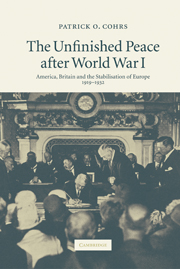Book contents
- Frontmatter
- Contents
- Acknowledgements
- List of abbreviations
- A note on the footnotes and bibliography
- Introduction
- Prologue
- 1 The wider challenges
- 2 Wilson, Lloyd George and the quest for a ‘peace to end all wars’
- 3 The ill-founded peace of 1919
- 4 The escalation of Europe's post-Versailles crisis, 1920–1923
- Part I The Anglo-American stabilisation of Europe, 1923–1924
- Part II Europe's nascent Pax Anglo-Americana, 1924–1925
- 11 The dawning of a Progressive Pax Americana in Europe?
- 12 Towards the Locarno pact
- 13 Regression?
- 14 Beyond irreconcilable differences?
- 15 The path to Locarno – and its transatlantic dimension
- 16 The second ‘real’ peace settlement after World War I
- Part III The unfinished transatlantic peace order: the system of London and Locarno, 1926–1929
- Epilogue
- Conclusion
- Map: Post-World War I Europe after the peace settlement of Versailles
- Bibliography
- Index
16 - The second ‘real’ peace settlement after World War I
The Locarno conference and the emergence of a new European concert
Published online by Cambridge University Press: 21 July 2009
- Frontmatter
- Contents
- Acknowledgements
- List of abbreviations
- A note on the footnotes and bibliography
- Introduction
- Prologue
- 1 The wider challenges
- 2 Wilson, Lloyd George and the quest for a ‘peace to end all wars’
- 3 The ill-founded peace of 1919
- 4 The escalation of Europe's post-Versailles crisis, 1920–1923
- Part I The Anglo-American stabilisation of Europe, 1923–1924
- Part II Europe's nascent Pax Anglo-Americana, 1924–1925
- 11 The dawning of a Progressive Pax Americana in Europe?
- 12 Towards the Locarno pact
- 13 Regression?
- 14 Beyond irreconcilable differences?
- 15 The path to Locarno – and its transatlantic dimension
- 16 The second ‘real’ peace settlement after World War I
- Part III The unfinished transatlantic peace order: the system of London and Locarno, 1926–1929
- Epilogue
- Conclusion
- Map: Post-World War I Europe after the peace settlement of Versailles
- Bibliography
- Index
Summary
Europe's second ‘real’ peace conference after the Great War opened on 5 October 1925, attended by delegates from Britain, France, Germany, Belgium and Italy. Following the British recommendation, the foreign ministers of Poland and Czechoslovakia, Skrzyński and Beneš, only joined the conference for the final deliberations on the eastern arbitration treaties. In contrast to the London conference, America was not represented, not even through unofficial observers. On 25 May, Houghton had still ‘hint[ed]’ to Chamberlain that the United States ‘might be prepared to participate in such a conference in the same way as they had done in the Reparation Conference’. Yet this remained an isolated overture. As Locarno centred on resolving what from Washington's perspective seemed intricate questions of European security, Kellogg never considered offering US mediation. And Chamberlain confided to Ambassador Howard that he could ‘not see how, in negotiations for a political pact of this character where no American co-operation can be expected, the presence of American unofficial or semi-official participants could really help us to a solution’.
Unlike London, Locarno was not a critical turning-point where the entire outcome was still at stake when the proceedings opened – or indeed the progress of postwar pacification as such. It was not a juncture where fundamental issues pertaining to the envisaged agreement still had to be resolved. Nor did it as yet furnish the occasion to resolve wider problems which then overshadowed European politics after 1925, notably the Rhineland question.
- Type
- Chapter
- Information
- The Unfinished Peace after World War IAmerica, Britain and the Stabilisation of Europe, 1919–1932, pp. 259 - 280Publisher: Cambridge University PressPrint publication year: 2006

